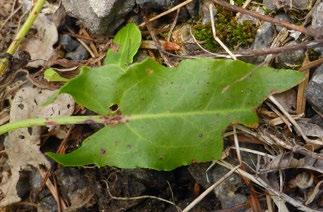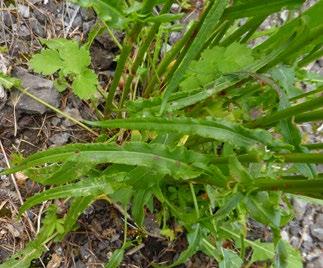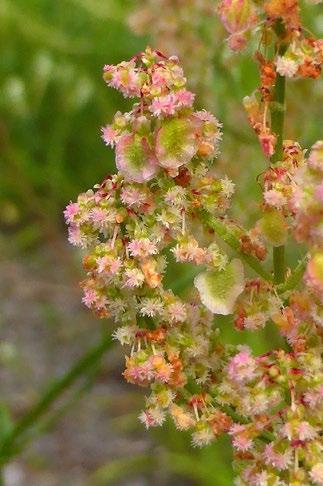
3 minute read
George Hounsome
Rumex thyrsiflorus Fingerh. in Surrey (v.c. 17)
GEORGE HOUNSOME
Advertisement
While walking along the cycleway on the west side of the Guildford Road north of Ottershaw, Surrey in July 2020, I noticed a plant with an unfamiliar jizz on the ‘wrong’ side of a fence, so I leapt over for a closer inspection. It was a sorrel (Rumex sp.) unlike any I’d seen before, multistemmed and about 45cm tall. The basal leaves were virtually gone but the stem leaves were narrow, much longer than wide, strongly sagittate, acute and with very wavy edges. The inflorescence was diffuse, much-branched with very small flowers and female. It was growing in a forest of Melilotus albus (White Melilot) and other ruderals. I later found another plant a few metres away on the ‘right’ side of that fence, at TQ 02414 64255, also female and with a few dilapidated basal leaves.
A conversation with Eric Clement produced the name Rumex thyrsiflorus Fingerh., a taxon completely new to me, so I sent photographs to Geoffrey Kitchener and John Akeroyd, the BSBI Rumex referees, for their opinions and they agreed that the name was correct, confirmed by Eric on receipt of a pressed specimen. It is closely related to the variable Rumex acetosa L. and may be confused with it, but the narrow, undulate, cauline leaves, becoming progressively narrower towards the top of the plant, and generally smaller valves of the fruit, 2.5–3mm rather than 3–4.5mm, set it apart. It also looks quite different, with a denser, mistierlooking inflorescence, although I must confess that this observation is based on a sample of only two plants. They set no ripe seeds. Flora Europaea has a description and key, and Blamey & Grey-Wilson (1989) has a drawing. There are descriptions in several online floras.
There are no records in the BSBI Distribution Database but Clement & Foster (1994) mentions an unconfirmed pre-1930 record from Sark in the Channel Islands; the stated islet of Brechou is incorrect (E.J. Clement, pers. comm.). There is a
Rumex thyrsiflorus at Ottershaw, Surrey (v.c. 17), showing general habit. Photographs by the author
confirmed record from Lanarkshire (Macpherson & McKean, 2014). The plant is a native of Central and Eastern Europe and is spreading across the rest of the continent as predicted in Lousley & Kent (1981), Akeroyd (2014) and, incidentally, by Rechinger, K.H. fil. personally to John Akerord in 1987! Sites on the internet give it the vernacular name Pyramidal Sorrel, but as it is not (yet) a British plant, how can it have an English name? Maybe that’s a translation from the name in one of the
many countries in its native range? John suggests that Thyrse Sorrel might be more appropriate, a thyrse being a type of inflorescence in which the main axis grows indeterminately but the branches have determinate growth.
The origin of the Ottershaw plants is unclear but this sorrel is a classic roadside weed of Central Europe and the plants were near a Christmas Tree farm. I don’t know from whence they source their saplings but they certainly employ Polish temporary staff in December so, as John suggests, maybe it came in on Polish car or lorry wheels. The plant on the right side of the fence was strimmed by the council in late summer, but the other is untouched. The species is perennial so I returned in July 2021 to see if they were still there. They were, looking very much as they did in 2020.
I would like to thank Eric Clement for bringing the species and the two other British records to my attention, and John Akeroyd and Geoffrey Kitchener for confirming the ID and giving me helpful comments on this note.
References
Akeroyd, J.R. 2014. Docks and Knotweeds of Britain and Ireland (2nd edn). Botanical Society of Britain and Ireland,
London. Blamey, M. & Grey-Wilson, C. 1989. The Illustrated Flora of
Britain and Northern Europe. Hodder & Stoughton, London. Clement, E.J. & Foster, M.C. 1994. Alien Plants of the British
Isles. Botanical Society of the British Isles, London. Lousley, J.E. & Kent, D.H. 1981. Docks and Knotweeds of the
British Isles. Botanical Society of the British Isles, London. Macpherson, P. & McKean, D.G. 2014. BSBI Scottish Newsletter 36, p.33.
George Hounsome
14 St John’s Rise, Woking, GU21 7PW george.hounsome@btinternet.com


Basal leaf (top) and cauline leaves (bottom). Female flowers and developing fruits.










